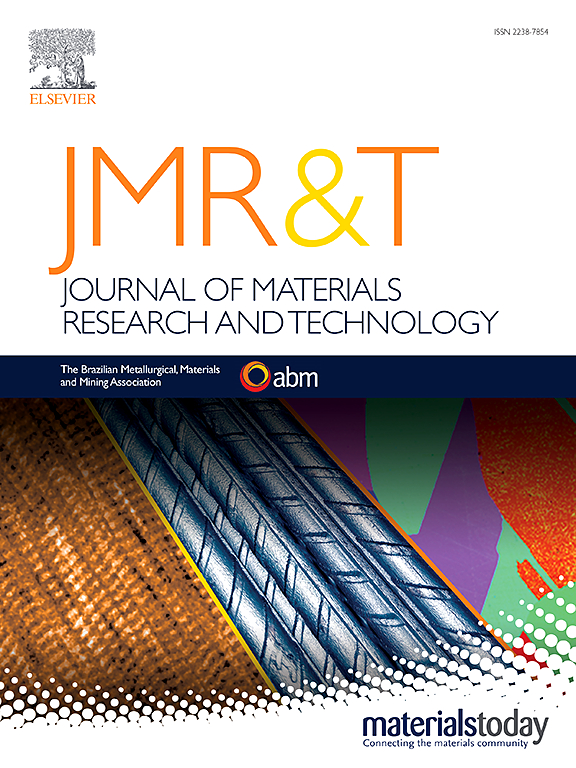High-throughput evaluation of Mo effect on hydrogen embrittlement behavior of ultra-high strength steel
IF 6.6
2区 材料科学
Q1 MATERIALS SCIENCE, MULTIDISCIPLINARY
Journal of Materials Research and Technology-Jmr&t
Pub Date : 2025-06-19
DOI:10.1016/j.jmrt.2025.06.149
引用次数: 0
Abstract
The susceptibility of high-strength hot-stamping steels to hydrogen embrittlement (HE) remains a critical challenge for their widespread adoption in automotive applications. In this study, we introduce a novel high-throughput methodology to assess the influence of molybdenum (Mo) content on the HE behavior of 32MnB5 steel. By integrating diffusion couple to create a Mo compositional gradient (0–0.6 wt%) and fabricating an array of microcantilevers via focused ion beam (FIB) milling, we employed nanoindentation to evaluate fracture toughness under both hydrogen-charged and hydrogen-free conditions. Microstructural characterization via electron backscatter diffraction (EBSD) and transmission electron microscopy (TEM) revealed that increasing Mo content slightly induces grain refinement and reduces localized stress concentrations, enhancing grain boundary cohesion and thereby increasing fracture toughness. Under hydrogen-charged conditions, however, hydrogen significantly reduces fracture toughness, with Mo exerting dual competing effects on the plastic component of fracture (Jplastic): grain refinement and reduction of localized stress concentrations enhance Jplastic, while lattice distortion exacerbates hydrogen-induced dislocation pinning, diminishing Jplastic. Consequently, Jplastic shows no significant variation with Mo content in the presence of hydrogen, yet overall, HE susceptibility decreases with higher Mo levels due to dominant elastic contributions. This high-throughput approach provides a robust alternative for rapidly screening alloy compositions to mitigate HE in advanced high-strength steels.
钼对超高强度钢氢脆行为影响的高通量评价
高强度热冲压钢对氢脆(HE)的敏感性仍然是其在汽车应用中广泛采用的关键挑战。在这项研究中,我们引入了一种新的高通量方法来评估钼(Mo)含量对32MnB5钢HE行为的影响。通过集成扩散偶来产生Mo成分梯度(0-0.6 wt%),并通过聚焦离子束(FIB)铣削制作微悬臂阵列,我们使用纳米压痕来评估带电和无氢条件下的断裂韧性。通过电子背散射衍射(EBSD)和透射电子显微镜(TEM)进行的显微组织表征表明,Mo含量的增加轻微地诱导了晶粒细化,降低了局部应力集中,增强了晶界凝聚力,从而提高了断裂韧性。然而,在带氢条件下,氢显著降低断裂韧性,Mo对断裂的塑性组分(j塑性)产生双重竞争作用:晶粒细化和局部应力集中的降低增强了j塑性,而晶格畸变加剧了氢诱导的位错夹紧,降低了j塑性。因此,在氢存在的情况下,j塑性随Mo含量的变化没有显著变化,但总体而言,由于主要的弹性贡献,Mo含量越高,HE敏感性越低。这种高通量方法为快速筛选合金成分以减轻高级高强度钢中的HE提供了可靠的替代方法。
本文章由计算机程序翻译,如有差异,请以英文原文为准。
求助全文
约1分钟内获得全文
求助全文
来源期刊

Journal of Materials Research and Technology-Jmr&t
Materials Science-Metals and Alloys
CiteScore
8.80
自引率
9.40%
发文量
1877
审稿时长
35 days
期刊介绍:
The Journal of Materials Research and Technology is a publication of ABM - Brazilian Metallurgical, Materials and Mining Association - and publishes four issues per year also with a free version online (www.jmrt.com.br). The journal provides an international medium for the publication of theoretical and experimental studies related to Metallurgy, Materials and Minerals research and technology. Appropriate submissions to the Journal of Materials Research and Technology should include scientific and/or engineering factors which affect processes and products in the Metallurgy, Materials and Mining areas.
 求助内容:
求助内容: 应助结果提醒方式:
应助结果提醒方式:


